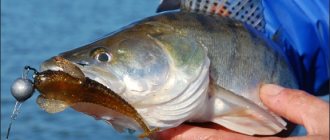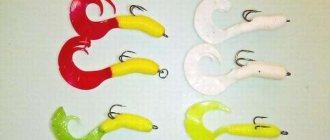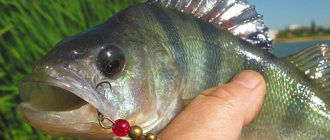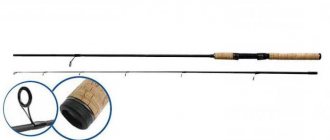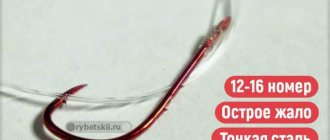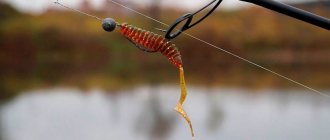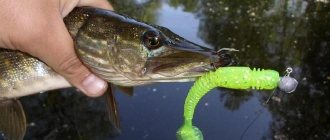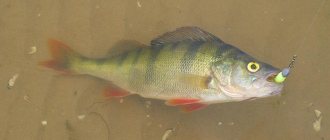Description of fishing method
It is no secret that trophy predators almost always stay in deep places at a significant distance from the shore. It is very problematic to get them from there using traditional equipment, so fishermen began to use a unique technique called “jig”, for which special jig baits are produced, consisting of two separate parts:
- The product itself.
- A jig head with a specific weight and shape.
If we are talking about fishing at impressive depths, then it is advisable to use heavy spinning baits, and lighter ones for shallow waters. As for the shape, it is chosen taking into account the nature of the bottom of the reservoir. If it is covered with a layer of silt, then a jig head with a flat base works great in such an area.
As with any other method of spinning fishing, for jig fishing it is necessary to use special wiring with the appropriate character. It is created as a result of the movements of the rod and the reeling of the fishing line. And although initially everything seems very simple and accessible, in order to acquire all the necessary skills you have to put in a lot of effort and time.
Making a jig head
The most popular jig load is a head made of lead or tin, which allows you to make your own load.
You can buy a wide variety of jig heads in stores; their range can satisfy the expectations of even the most sophisticated anglers, who sometimes choose intricate head models. Therefore, many people use what is available for sale. But what should an angler do if he often fishes with a spinning rod in a reservoir with numerous hooks and is forced to buy a new batch of jigs every few days? During the season, the cost of purchased jigs can reach a significant amount, and the home budget! It won't always hold up. In this case, you can independently make heads suitable for your favorite body of water.
To do this, you need to either buy a ready-made matrix, and then make the necessary heads, or make the matrix yourself.
The degree of complexity of manufacturing the matrix depends on the material used for its manufacture. You can make a matrix for casting heads at home, but you will have to try. Even in an emergency situation, in spartan conditions, when there are no plumbing tools at hand, it is also possible to make a matrix for urgently needed heads. The jigs won't be perfect, but they will get the job done. However, do not forget that the matrix and lead alone are not enough - to make a jig you will need ready-made high-quality hooks of the appropriate design. They are bought in a specialized store, carefully selecting the size and model of the hook to the model of the heads cast using a matrix, and taking into account existing jig baits.
Read: Sea fishing with jig and popper baits
You can make a matrix from aluminum, steel or other hard metal that can withstand local heating in a workshop.
To make the matrix, you will need two identical metal blocks, in which, on a precision milling machine, you need to make holes for the head (of any shape), a hook, a hook ring, a notch on the head, channels for removing hot gases, and a funnel for injecting lead. Manufacturing such a matrix requires good skills in working on a metalworking machine and is quite expensive. From an economic point of view, it is justified only because it allows you to refuse to buy jigs in a store and cast your favorite head models yourself. It should be remembered that the matrix does not make it possible to change the size of the load, and the hole made once remains unchanged. To make larger or smaller heads, you need to make a new die or a die with new options.
To cast heads yourself, you can use a factory die, the shape and size of which is selected for your own needs. It is small and easy to transport, so it can be used to replenish the stock of jigs, for example on a fishing trip lasting several days if more jigs are lost than expected. You will also need hooks, a supply of lead, and a container for melting lead. Of course, you should also provide access to a gas burner or stove.
Read: Fishing with very light baits
Emergency Matrix
You need to prepare the following materials and preparations:
- A flat box, such as margarine, yogurt, etc.
- Fat in the form of grease, Vaseline, etc.
- Standard ready-made jig head or jig (without bait).
- Container for preparing plaster.
- Putty gypsum, dental gypsum, or, in extreme cases, cement.
- Water.
- Sharp knife.
- Coarse and fine grain sandpaper.
- Four nails or straight and solid dowels (as stabilizer connectors of the two halves of the matrix).
- Lead.
- Access to a heat source, such as a gas burner, electric or gas stove, stove with stove, etc.
Follow these steps:
- The container for the matrix must be lubricated with a thin layer of grease.
- Dilute gypsum or cement in the amount necessary to create a layer 4-6 cm thick in the existing container.
- Pour the plaster into the container and wait for it to harden slightly.
- Grease the pattern head or jig.
- When the plaster has hardened so much that it will be pressed, but will not crack or blur, deforming the print (and the head will not sink), you need to press the head or jig, but only to half the height (thickness). To make it easier to create the matrix, we recommend cutting off the hook hook.
- Insert fixing pins (eg nails without heads), also greased.
- Leave half of the matrix to dry.
- After drying, apply lubricant to the surface of the matrix. We do not recommend using olive or liquid machine oil.
- Pour another portion of plaster of the same thickness, that is, 4-6 cm.
- Leave until completely dry and hardened.
- Separate the halves by prying one of them in the corner with a flat kitchen knife or bookbinding knife.
- After separation, you need to pull out the sample head and evaluate the quality of the resulting matrix. If necessary, correct the indentations (ovality, smoothness) with a sharp knife or needle.
- With the tip of a knife or needle, you need to make two shallow grooves leading outward from the head, through which the hot gases released during pouring of lead will escape.
- Use a knife (drill, chisel, sharpened wire, etc.) to make a symmetrical hole for pouring lead. The shape of the hole resembles a funnel.
- After these steps, the matrix is ready for use.
- You need to insert a hook into the print (prying and the tip of the hook should protrude from the matrix), put the second half of the matrix, then tie them, for example, with a strong elastic band or self-adhesive tape. We do not recommend using metal clamps
- With the die positioned with the hole facing up, pour in the lead.
- After cooling, you need to process the head - for example, remove angular sagging with a sharp knife.
- If the hook in the head moves, it can be fixed with instant glue.
- You can put bait on the hook and go fishing.
Jig fishing
Choosing the right rod
The key to successful fishing is the correct choice of jig rod . This issue needs to be approached with special responsibility, because the effectiveness and comfort of fishing directly depends on it. It is important to choose those blank models that have a certain set of characteristics that correspond to the parameters of the bait. Otherwise, you will not be able to plausibly present the product to the fish and then successfully hook it. The fisherman needs to fully feel the bait, knowing when the moment of bite comes.
Among the key criteria influencing the upcoming choice are fishing conditions. You must understand that different gear with different parameters is selected for shore and boat fishing.
If we talk about fishing from a boat, then using long forms is the wrong decision, because with such a tool it will be problematic to cast and catch prey. Therefore, the ideal option is a 1.9-2.4 meter blank, which will not cause discomfort to the fisherman and interfere with the convenience of fishing.
For shore fishing, the following philosophy is used: the longer the spinning rod, the easier it will be to cast the bait over a long distance. However, along with the length, the mass of the tool also increases, so this increases the load on the hands. Also, vegetation is often present in the coastal zone, which complicates the use of long blanks. Therefore, experts recommend choosing 2.7-3-meter models, which are quite sufficient for most fishing conditions.
Spinning rod parameters
All fishing rods are conventionally divided into several categories , which are compiled depending on their nature, including action. For a beginner jig spinner, blanks with fast or super-fast action are perfect, which will allow you to perform high-quality and reliable hooking. In addition, such inventions react more sensitively to bites, which increases the chances of performing an accurate strike at the most opportune moment.
When choosing a reliable fishing rod for fishing with a jig head for pike, perch or pike perch, pay attention to the test load indicators. They indicate the maximum weight of the bait that can be used on a particular form with the ability to control the retrieve. Currently, there are three groups of fishing rods that differ in test characteristics:
- In the first group there are models for ultralight fishing, the test of which reaches 10 grams. It is advisable to buy them when catching small predators, such as perch or pike perch.
- The second group contains forms with a test load from 10 to 30 grams. With their help, you can comfortably catch larger prey, the weight of which reaches 10 kilograms. As a rule, it is these spinning rods that are used by domestic fishermen, as they are suitable for our natural conditions.
- The third group included models with test values from 30 grams. They are especially effective for deep-sea fishing and casting jig baits for pike into remote areas of the reservoir. If you are going to fish on a river with intense currents, then this option is the most suitable.
When choosing a good spinning blank, take into account the material of manufacture. It is advisable to choose good models from trusted manufacturers, which are created on the basis of modern materials with high strength and, most importantly, low weight. However, such fishing tools are not cheap, so a beginner may find them difficult to access .
Classifications
Jig head is the name given to a sinker that has a certain shape with a hook attached to it. It is very effectively used when fishing with baits designed for spinning rods of various lengths. The jig head is classified quite simply and very clearly. Firstly, by weight: in most cases, the weight of this sinker is indicated directly on it in gram equivalent. However, experienced fishermen easily rank its weight, despite wear or scratches from zander or pike teeth, determining which jig head is in front of them by “eye”.
According to its method of fastening, this sinker can be stationary or articulated, which is also affectionately called “ushastik” or “Cheburashka”. Despite the fact that the mass of both the first and the second may be the same, the difference between them is quite noticeable.
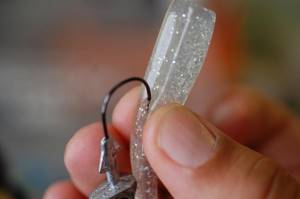
Best jig reel
When planning to assemble jig tackle with your own hands, it is also important to choose a good reel. And although high demands are not placed on this element, for comfortable fishing it is better to choose high-quality and functional solutions.
In most cases, for this direction of spinning fishing, an inertia-free model with the appropriate size is used. Today, functional multipliers are widespread, but only experienced fishermen know how to use them. Most often, multiplier products are indispensable for catching large-sized prey, for example, for catching catfish. For the average spinning player, a regular, easier-to-use, inertia-free reel will be sufficient.
Experienced fishing masters recommend giving preference to models with a characteristic spool coating. After all, if you wind expensive braid on a plastic spool, it will quickly wear out and completely fail. This is explained by certain features of the structure of the braid, which has abrasive properties. As for the classic monofilament line, it is more stable and is not afraid of such influences.
Spinning line
Many fishermen use monofilament line, proven over the years and experience, for jig fishing on small rivers and lakes, although braided line is also used quite often. However, the cost of the latest invention is very high, so not all beginners can afford to buy it. However, monofilament has significant disadvantages, including:
- Increased specific load.
- Less strength.
- The presence of a “memory effect”.
In some situations, monofilament line is more effective than the most expensive braid, so it all depends on many individual characteristics .
To choose the appropriate line option for your spinning tackle, be sure to study the fishing conditions. For long distances, braids are excellent because they more quickly transfer the moment of bite to the tip of the rod. When fishing at a short distance, monofilament is suitable, because here its stretchability practically does not affect the performance. In addition, it significantly dampens the jerks of a large predator.
Catching baits and baits
For modern jig fishing, two types of baits are used:
- Made from foam rubber.
- Silicone products.
If we talk about the first category, it includes many classic baits that are available at a low price in any fishing store. In addition, they are easy to make with your own hands, which is what experienced spinners do. In this case, it is possible to make several inexpensive devices with minimal costs.
In turn, silicone baits appeared much later, but began to rapidly gain popularity, having many advantages. There is a wide variety of silicones on sale in different sizes, colors and shapes. Due to the unique properties of silicone, manufacturers have managed to bring to the market truly catchy jig baits that perfectly imitate the play of real fish, as well as insects or any other inhabitants of the depths. To increase efficiency, flavors are added to silicone, as a result of which the number of bites increases significantly. This produces the popular edible rubber.
Also for jig fishing, combined solutions are used, which are created from old, damaged silicone baits. Due to easy processing under the influence of temperature, silicone that has become unusable quickly becomes a new, functional bait. It is enough to pick up soldering equipment, and perhaps you will be able to invent a real masterpiece.
Stationary variety
A stationary jig head involves a rigid connection of the sinker with the hook. It appeared very first, so it was considered a classic for a long time. But even now, when joints appeared, the stationary jig head still did not disappear from the boxes of fishermen. And that's why.
Due to its rigid connection, the hook, which is threaded into the silicone bait, is almost always positioned with the tip up. This position is considered the most successful for effective hooking. In addition, during wiring, the so-called “sticking” of the hook attached to the load ring never occurs. And one more thing: with a stationary installation, the game turns out to be as measured and smooth as possible, without any glitches, which is what predatory fish require.
However, fishing with a jig head for this species also has its disadvantages. Firstly, due to the significant drag - the result of a rigid connection - the casting distance is noticeably reduced. In addition, for the same reason, such installation takes longer to sink to the bottom, although this is often a plus. Thirdly, the angler does not have the opportunity to vary the size of the bait, placing only the one that fits the hook of a given sinker. And finally, in some cases, when fishing, the prey is released, and the same rigid connection is used as a lever.
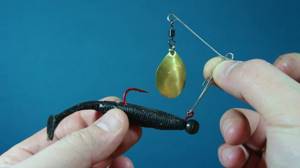
Jig head installation
How to attach the chosen bait to a jig is a question that many beginners face. Today, several installation options are used, which are determined by the nature of the load:
- Rigid mount. It is particularly simple and uncomplicated. In this case, it is necessary to connect the jig head to the bait so that the weight is placed in front of the bait, and the point of the hook goes up.
- Flexible mount. Using this technique, you can recreate a more vivid game of the bait. The product must be put on a hook, and a weight, for example, based on Cheburashkas, must be connected to the hook using a winding ring. For equipment, both conventional hooks with a long shank and offset ones are used. The last option is effective for creating so-called non-clings.
Regardless of the installation features , it is important to choose the right hook size so that it matches the size of the bait. Very often, single hooks are replaced with doubles or treble hooks, which significantly increases fishing efficiency, but also increases the number of snags of the equipment on snags, stones and other underwater obstacles.
You can find out how to attach bait to a jig head from experienced spinning colleagues, or look it up on the Internet.
It is preferable to choose spherical products as a sinker. They are effective for any spinning fishing conditions and are affordable, while being easy for a beginner to set up. In addition to spherical products, so-called boots, or irons, are popular, which are often used for attaching vibrating tails and other small silicones.
Fishing with a jig head
The simplest is not always the best.
Alas, the jig head also has two serious drawbacks: firstly, only the tail of the silicone bait plays on a rigid mount, and secondly, the single hook does not detect and hold the fish well enough.
This is especially true for pike - not only does the spotted pike have a hard mouth studded with teeth, it has two long cavities in the upper jaw, covered only with thin skin, into which a single hook often falls.
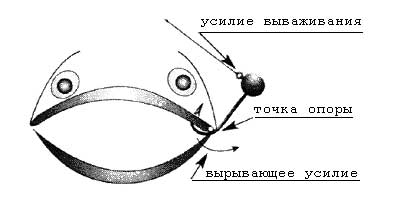
Fig.3. Snatching force when fishing with hard rigs.
When fishing, the pike begins to shake its head, the hard jig head acts as a lever (Fig. 3) - the skin breaks through and the hook pops out.
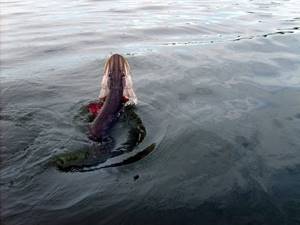
There are many mishaps when catching pike perch: the fanged one can also grab the bait from any direction, sometimes with the very edge of its mouth, and sometimes it “hits with its gills.” In such cases, a single fishing rod, alas, does not always reliably detect the fish, so here too it is irrational to use a jig head, except in snaggy places or when scouting in unfamiliar waters.
Thus, it is better to use a jig head in the following cases:
- For beginning spinning anglers - as the simplest and cheapest equipment.
- Small fish (perch, bass, etc.) or a good bite when several catches will not ruin your mood.
- Fishing with light jig heads among the algae - much less snagging.
- Scouting in unfamiliar places and fishing in “cluttered” places, fraught with frequent snags and breaks, means less loss of bait, especially if the hook unbends without breaking the braid.
- The bite may be better on special jig heads - for example, standing jig heads, when retrieved with stops and dragged along the bottom due to a raised hook, are better at “giving” the bait and detecting fish.
- When a predator clearly “hits from above” and presses the bait to the bottom, there are more effective hooks on the jig head.
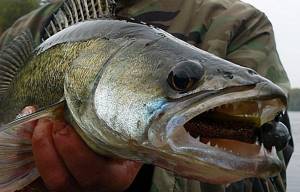
In all other cases, free (hinged) equipment of jig baits is preferable.
